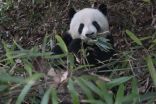Pandas spend less energy to afford bamboo diet
2015-07-09
(Press-News.org) This news release is available in Japanese.
A suite of energy-saving traits, including underactive thyroid glands, allows giant panda bears to survive almost exclusively on bamboo, according to a new study. Yonggang Nie and colleagues report the first measurements of daily energy expenditure (DEE) in these bears, which do not have stomachs designed for such low-nutrient, high-cellulose plants. The researchers studied five captive pandas and three wild ones, discovering that the animal's DEE was just about 38% of the average for a terrestrial mammal with the same body mass. The DEE values for giant pandas are substantially lower than those for koalas, for example, and more akin to those of three-toed sloths, according to the researchers. Nie et al. used GPS loggers to track the bears and found that giant pandas are much less active than other bears. Further research revealed that the animal's brain, liver, and kidney are relatively small compared to other bears, and that its thyroid hormone levels are only a fraction of the mammalian norm -- comparable to a hibernating black bear's hormone levels. Finally, the researchers compared the giant panda genome to those of other mammals, identifying a panda-specific variation on the DUOX2 gene, loss of which is associated with underactive thyroids in humans. Taken together, these results suggest that particularly low energy expenditures and thyroid hormone levels enable the carnivorous-looking panda bears to munch on bamboo all day.
INFORMATION:
Note: Science's Digital Media team created a video related to this research that will be available at the following URL when the embargo lifts. http://scim.ag/panda6243 The video explores how pandas make the most of their low-nutrient bamboo diet
Article #10: "Low daily energy expenditure and metabolic rate in the bamboo-eating giant panda," by Y. Nie; J.R. Speakman; Q. Wu; Y. Hu; L. Yan; L. Wang; W. Wei; F. Wei at Chinese Academy of Sciences in Beijing, China; J.R. Speakman; C. Hambly at University of Aberdeen in Aberdeen, UK; C. Zhang; M. Xia; J. Zhang at Beijing Zoo in Beijing, China.
ELSE PRESS RELEASES FROM THIS DATE:
2015-07-09
This news release is available in Japanese. How does the Campi Flegrei caldera, or subsurface rock, near Naples, Italy, withstand more uplift than other calderas without erupting? A new study shows that the caprock underlying this particular caldera closely resembles ancient Roman concrete -- and that the rock's microstructures, characterized by intertwining fibrous minerals, lead to its exceptionally high strength. The findings help to explain how the caldera has been able to withstand tremendous deformation, such as the large uplift episode that began in 1982 and raised ...
2015-07-09
This news release is available in Japanese.
While the geographic ranges of many animals are expanding northward in response to climate change, those of North American and European bumblebee species are shrinking, a new study shows. These insects are failing to migrate northward, the study reveals, and in their southern territories, their ranges are compressing -- with range losses up to 300 kilometers in both North America and Europe. The findings reveal the vulnerability of these pollinators, which play key roles in agriculture, to a warming world, hinting that they ...
2015-07-09
This news release is available in Japanese.
Researchers have designed a more efficient jumping robot with three-dimensional (3D) printing techniques and a combination of hard and soft materials. Inspired by designs in nature, such as snakes or insect larvae, soft-bodied robots are safer, more adaptable, and more resilient than their traditionally rigid counterparts, but molding and powering them has proved challenging. Now, Nicholas Bartlett and colleagues report a technique for designing and manufacturing untethered, frog-like jumping machines with ...
2015-07-09
Traditional industrial robots are rigid -- mostly metal -- and are fast, precise and powerful. Their speed and precision comes at the cost of complexity and can often pose a danger to humans who get too close. Soft robots are adaptable and resilient but slow, difficult to fabricate, and challenging to make autonomous because most motors, pumps, batteries, sensors, and microcontrollers are rigid.
But what if you could combine the autonomy and speed of a rigid robot with the adaptability and resiliency of a soft robot -- and do it relatively cheap and fast?
Harvard engineers ...
2015-07-09
Monterey, CA - Thousands of feet below the ocean's surface lies a hidden world of undiscovered species and unique seabed habitats--as well as a vast untapped store of natural resources including valuable metals and rare-earth minerals. Technology and infrastructure development worldwide is dramatically increasing demand for these resources, which are key components in everything from cars and modern buildings to computers and smartphones. This demand has catalyzed interest in mining huge areas of the deep-sea floor.
In a paper published this week in Science, researchers ...
2015-07-09
Engineers at Harvard University and the University of California, San Diego, have created the first robot with a 3D-printed body that transitions from a rigid core to a soft exterior. The robot is capable of more than 30 untethered jumps and is powered by a mix of butane and oxygen. Researchers describe the robot's design, manufacturing and testing in the July 10 issue of Science magazine.
"We believe that bringing together soft and rigid materials will help create a new generation of fast, agile robots that are more robust and adaptable than their predecessors and can ...
2015-07-09
New York, 9 July - Investing up to 3.5% of a nation's GDP in science, technology and innovation - including basic science and education - is a key benchmark for advancing sustainable development effectively, leading experts say.
In papers released July 9 in New York, international scientists advising UN Secretary-General Ban Ki-moon say closing the gap between developed and developing countries depends on first closing international science, technology and innovation (STI) investment gaps.
According to the UN SG's 26-member Scientific Advisory Board: "While a target ...
2015-07-09
Black holes can be found at the centres of most galaxies. Most have little mass compared with their host galaxy. ETH researchers, however, have discovered a particularly massive black hole, which clearly grew so quickly that the host galaxy was not able to keep pace. This calls into question previous thinking on the co-evolution of galaxies and their central black holes.
Benny Trakhtenbrot, a researcher at ETH Zurich's Institute for Astronomy, together with an international team of astrophysicists, was hunting for ancient massive black holes using the 10 meter Keck telescope ...
2015-07-09
Many areas of fundamental research are interested in graphene owing to its exceptional characteristics. It is made of one layer of carbon atoms, which makes it light and sturdy, and it is an excellent thermal and electrical conductor. Despite its apparently limitless potential, however, few applications have been demonstrated to date. Scientists at EPFL's Bionanophotonic Systems Laboratory (BIOS) together with researchers from the Institute of Photonic Sciences (ICFO, Spain) have now added another one. They have harnessed graphene's unique optical and electronic properties ...
2015-07-09
CORVALLIS, Ore. - A new review analyzing three decades of research on the historic effects of melting polar ice sheets found that global sea levels have risen at least six meters, or about 20 feet, above present levels on multiple occasions over the past three million years.
What is most concerning, scientists say, is that amount of melting was caused by an increase of only 1-2 degrees (Celsius) in global mean temperatures.
Results of the study are being published this week in the journal Science.
"Studies have shown that both the Greenland and Antarctic ice sheets ...
LAST 30 PRESS RELEASES:
[Press-News.org] Pandas spend less energy to afford bamboo diet








